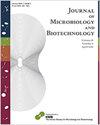Human Placenta Extract (HPH) Suppresses Inflammatory Responses in TNF-α/IFN-γ-Stimulated HaCaT Cells and a DNCB Atopic Dermatitis (AD)-Like Mouse Model.
IF 2.5
4区 生物学
Q3 BIOTECHNOLOGY & APPLIED MICROBIOLOGY
引用次数: 0
Abstract
Atopic dermatitis (AD), a chronic inflammatory disease, severely interferes with patient life. Human placenta extract (HPH; also known as human placenta hydrolysate) is a rich source of various bioactive substances and has widely been used to dampen inflammation, improve fatigue, exert anti-aging effects, and promote wound healing. However, information regarding HPH's incorporation in AD therapies is limited. Therefore, this study aimed to evaluate HPH's effective potential in treating AD using tumor necrosis factor (TNF)-α/interferon (IFN)-γ-stimulated human keratinocytes (HaCaT), immunized splenocytes, and a 2,4-dinitrochlorobenzene (DNCB)-induced AD mouse model. In TNF-α /IFN-γ-stimulated HaCaT cells, HPH markedly reduced the production of reactive oxygen species (ROS) and restored the expression of nuclear factor erythroid 2-related factor 2 (Nrf2), superoxide dismutase 1(SOD1), catalase, and filaggrin (FLG). HPH reduced interleukin (IL)-6; thymus- and activation-regulated chemokine (TARC); thymic stromal lymphopoietin (TSLP); and regulated upon activation, normal T cell expressed and presumably secreted (RANTES) levels and inhibited nuclear factor kappa B phosphorylation. Additionally, HPH suppressed the T helper 2 (Th2) immune response in immunized splenocytes. In the AD-like mouse model, it significantly mitigated the DNCB-induced elevation in infiltrating mast cells and macrophages, epidermal thickness, and AD symptoms. HPH also reduced TSLP levels and prevented FLG downregulation. Furthermore, it decreased the expression levels of IL-4, IL-5, IL-13, TARC, RANTES, and immunoglobulin E (IgE) in serum and AD-like skin lesion. Overall, our findings demonstrate that HPH effectively inhibits AD development and is a potentially useful therapeutic agent for AD-like skin disease.人胎盘提取物(HPH)可抑制TNF-α/IFN-γ刺激的HaCaT细胞和DNCB特应性皮炎(AD)样小鼠模型的炎症反应。
特应性皮炎(AD)是一种慢性炎症性疾病,严重影响患者的生活。人胎盘提取物(HPH,又称人胎盘水解物)富含多种生物活性物质,已被广泛用于抑制炎症、改善疲劳、抗衰老和促进伤口愈合。然而,有关将 HPH 纳入 AD 疗法的信息还很有限。因此,本研究旨在利用肿瘤坏死因子(TNF)-α/干扰素(IFN)-γ刺激的人角质形成细胞(HaCaT)、免疫脾细胞和2,4-二硝基氯苯(DNCB)诱导的AD小鼠模型,评估HPH治疗AD的有效潜力。在 TNF-α /IFN-γ 刺激的 HaCaT 细胞中,HPH 显著减少了活性氧(ROS)的产生,并恢复了核因子红细胞 2 相关因子 2(Nrf2)、超氧化物歧化酶 1(SOD1)、过氧化氢酶和丝胶蛋白(FLG)的表达。HPH降低了白细胞介素(IL)-6、胸腺和活化调节趋化因子(TARC)、胸腺基质淋巴生成素(TSLP)以及活化时调节的正常T细胞表达和推测分泌(RANTES)水平,并抑制了核因子卡巴B的磷酸化。此外,HPH 还能抑制免疫脾细胞的 T 辅助细胞 2(Th2)免疫反应。在类注意力缺失症小鼠模型中,HPH 能显著缓解由 DNCB 引起的浸润肥大细胞和巨噬细胞、表皮厚度和注意力缺失症状的增加。HPH还能降低TSLP水平,防止FLG下调。此外,它还降低了血清和AD样皮损中IL-4、IL-5、IL-13、TARC、RANTES和免疫球蛋白E(IgE)的表达水平。总之,我们的研究结果表明,HPH能有效抑制AD的发展,是一种治疗AD样皮肤病的潜在药物。
本文章由计算机程序翻译,如有差异,请以英文原文为准。
求助全文
约1分钟内获得全文
求助全文
来源期刊

Journal of microbiology and biotechnology
BIOTECHNOLOGY & APPLIED MICROBIOLOGY-MICROBIOLOGY
CiteScore
5.50
自引率
3.60%
发文量
151
审稿时长
2 months
期刊介绍:
The Journal of Microbiology and Biotechnology (JMB) is a monthly international journal devoted to the advancement and dissemination of scientific knowledge pertaining to microbiology, biotechnology, and related academic disciplines. It covers various scientific and technological aspects of Molecular and Cellular Microbiology, Environmental Microbiology and Biotechnology, Food Biotechnology, and Biotechnology and Bioengineering (subcategories are listed below). Launched in March 1991, the JMB is published by the Korean Society for Microbiology and Biotechnology (KMB) and distributed worldwide.
文献相关原料
| 公司名称 | 产品信息 | 采购帮参考价格 |
|---|
 求助内容:
求助内容: 应助结果提醒方式:
应助结果提醒方式:


